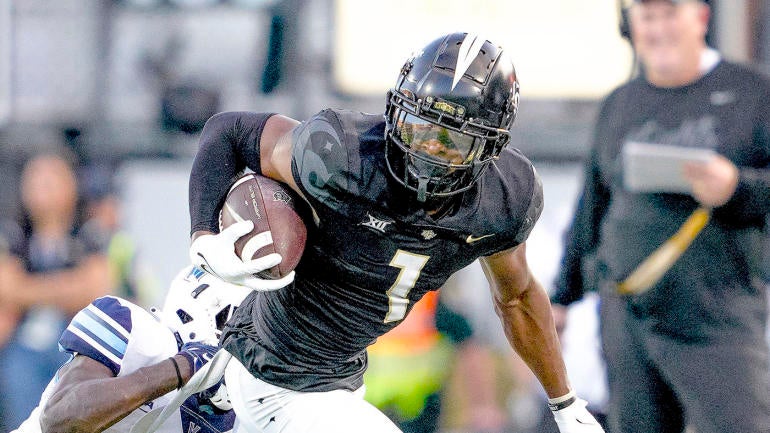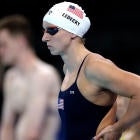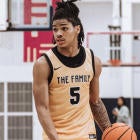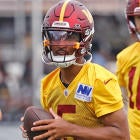
Every year in the NFL Draft, teams often are not able to pick the exact prospect they covet most early.
So that means plenty of analysis of marquee prospects falls on deaf ears for many fans. You know Marvin Harrison Jr. is a blast on film, right? But unless you're a fan of a team picking the top five and top six, Harrison won't be wearing your team's colors in the fall. So are there any receivers like Harrison who'll be available on Day 2 or Day 3?
You've come to the right place. This article pinpoints "Plan B" and "Plan C" options for some of the most highly coveted prospects in the 2024 draft class.
Last year's Plan B prospects included De'Von Achane, Sam LaPorta and Marvin Mims.
Quarterback
| QB Prospect | |
|---|---|
Plan A | Drake Maye, North Carolina |
Plan B | Spencer Rattler, South Carolina |
Plan C | Devin Leary, Kentucky |
Rattler was hardly anyone's "Plan B" after the 2021 season at Oklahoma, when he dazzled every defense in the Big 12 and felt like the next in line at quarterback out of Lincoln Riley's offense. Sure, he had a rollercoaster ride since then, but he settled into his own at South Carolina and was the author of some of the finest, high-degree-of-difficulty throws over the past two seasons in the SEC.
Not too dissimilar from Rattler, Leary was once regarded as an eventual big-time quarterback. In 2021, he completed nearly 66% of his throws at 8.0 yards per attempt with 35 touchdowns and five picks at NC State. The wheels fell off the final season, and he didn't get a massive boost transferring into the SEC at Kentucky, yet his film is relatively chock full of pro-caliber throws from within the pocket. The velocity and anticipatory throws are there, and traits are an important facet of the quarterback position.
Running back
| RB Prospect | |
|---|---|
Plan A | Jonathan Brooks, Texas |
Plan B | Tyrone Tracy, Purdue |
Plan C | Isaiah Davis, South Dakota State |
Tracy is one of the older prospects in the class. I usually don't love that. Particularly for running backs. Tracy is an exception to the rule because he hardly touched the football in college and was always hyper-effective when he did. A former receiver at Iowa, Tracy has a mere 146 carries to his name and averaged right around 7.0 yards per tote in 2022 and 2023 combined. He exudes unique elusiveness, and, at 5-foot-11 and 209 pounds, ran 4.48 with a 40-inch vertical at the combine.
Davis is probably the most underrated back in the class, and it's all because he played at the FCS level. South Dakota State is a powerhouse at that level and did just win the title in that division at the end of the 2023 season. After averaging over 7.0 yards per attempt on under 100 carries in 2020 and 2021, and assuming lead-back duties in 2023, the sizable runner went over 1,400 yards in consecutive seasons for the Jackrabbits and tested like a premier athlete at the combine. His 34.5-inch vertical and 9-foot-11 broad indicate he has NFL juice in his lower half and he looks like a feature back at 6-foot and 218 pounds.
Wide receiver
| WR Prospect | |
|---|---|
Plan A | Marvin Harrison, Jr. Ohio State |
Plan B | Javon Baker, UCF |
Plan C | Ryan Flournoy, SE Missouri State |
I've been on Baker all draft season, so I'm compelled to highlight him here. The former four-star recruit began his college journey at Alabama and blossomed into a star post-transfer to UCF, where he averaged nearly 17 yards per snag in his two years with the Knights. And on film, I saw a complete wideout -- releases from press coverage, flexibility and nuance as a route-runner, and the hops and concentration to star in combat-catch scenarios. Sure, he only ran 4.54 at the combine, and that's why he's a Plan B option.
At 6-0 and over 200 pounds, Flournoy has exceptionally explosive traits -- 4.44 in the 40-yard dash, 39.5-inch vertical, and 11-foot broad. And everything he demonstrated in those drills at the combine appears on film. He was a regular deep-ball weapon in his collegiate offense, and I love that he plays with authority after the catch, demonstrating an awesome blend of power and smoothness to either run out of tackles or elude them altogether.
Tight end
| TE Prospect | |
|---|---|
Plan A | Brock Bowers, Georgia |
Plan B | Ben Sinnott, Kansas State |
Plan C | A.J. Barner, Michigan |
Sinnott is a serious prospect. To me, he should have hype leading into this draft. My justification is two-fold -- this is a tight end who caught 80 passes across the past two seasons at right around 14 yards per grab, a hefty number for a tight end, and he's a premier athlete. Sinnott did run 4.68 but lept 40 inches into the air in the vertical test and had an ultra-quick 6.82 time in the three-cone. Oh, and his 10-foot-6 broad was the longest among everyone at his position. Sinnott is an athletic, plus pass catcher, exactly what teams are scouring for at tight end today.
I'll start off with, yes, Barner is a quality blocker. Least-surprising thing in the draft, given that he played for Jim Harbaugh at Michigan. And that's a nice luxury to have, in a league in which legitimately capable blockers at tight end is becoming a scarcity. But beyond that, it's Barner's smoothness and pass-catching upside that led to this Plan C distinction. He glides off the snap and when changing directions in his routes. To cap it off, Barner flashed some run-after-the-catch skill.
Offensive tackle
| OT Prospect | |
|---|---|
Plan A | Taliese Fuaga, Oregon State |
Plan B | Christian Jones, Texas |
Plan C | Nathan Thomas, Louisiana |
Jones is a fun, high-energy masher on film. At 6-foot-5 and 305 pounds with arms over 35 inches, he has the exact body type teams should be looking for when locating high-upside offensive tackles beyond the first round. I won't call him a freaky athlete, but the fundamentals are through the roof, which isn't surprising given he appeared in 61 games at Texas. His hand work is accurate and well timed, and there's a real nastiness to his game.
Much of what's written above with Jones applies to Thomas, except with Thomas there's more natural power. Despite that, the sense I get is Thomas will be picked after his Texas counterpart, therefore the Ragin' Cajun gets the nod as a Plan C for the offensive tackle position. Thomas is 6-foot-5, 332-pounds with nearly 34-inch arms and a 83-inch wingspan. And he gets after it as much -- if not more -- than Jones does for the run game and can really anchor in pass protection.
Interior offensive line
| IOL Prospect | |
|---|---|
Plan A | Jackson Powers-Johnson, Oregon |
Plan B | Sedrick Van Pran, Georgia |
Plan C | Beaux Limmer, Arkansas |
Van Pran was on the draft radar a season ago, and he decided to return to Georgia. In that final season with the Bulldogs, the strong yet nimble center was rock solid in pass protection -- only 13 pressures surrendered in nearly 500 pass-blocking snaps -- and is one of the most assignment-sound combo blockers for the run game. With more power added to his game, he can be a stud center for a decade in the NFL.
Now, Limmer probably won't go way later, so as a Plan C, we're talking fourth round here, maybe fifth. Like Van Pran, this is a multi-year boulder of a center in the SEC who is powerful and explosive. The proof? He had a 36.5-inch vertical (98th percentile at the position) and did 39 bench-press reps at 225 pounds. He's a freakish specimen and plays with tremendous balance.
Edge rusher
| EDGE Prospect | |
|---|---|
Plan A | Dallas Turner, Alabama |
Plan B | Gabriel Murphy, UCLA |
Plan C | Jalyx Hunt, Houston Baptist |
Let's hope Murphy gets with a creative defensive coordinator. Because he's small and has short arms. Beyond that, he's a devastatingly slippery pass rusher. I wrote in my notes that he "might have the best collection of pass-rushing moves in the entire class." As a movable chess piece up front, Murphy can be a stellar pass-rush specialist in the NFL, and probably won't go off the board until the third or fourth round.
Hunt is a former safety who, during his collegiate career, was asked to bulk up to play a hybrid linebacker/edge-rusher position. In his final season at Houston Baptist, he generated a pressure on over 16% of his pass-rushing snaps. He now as NFL-caliber size at nearly 6-foot-4 and 252 pounds and has serious acceleration with 37.5-inch vertical and a 10-foot-8 in the broad. Want a moldable ball of clay at defensive end? This is the guy.
Defensive tackle
| DT Prospect | |
|---|---|
Plan A | Byron Murphy, Texas |
Plan B | Michael Hall Jr., Ohio State |
Plan C | Tyler Davis, Clemson |
Hall won't be 21 until May, but was a disruptive force at Ohio State in his three-year stay with the Buckeyes. He tested a bit better than I expected based on the film and, like the vast majority of rushers hailing from Columbus, he deploys a large variance of pass-rushing maneuvers to beat interior blockers.
Davis' teammate, Ruke Orhorhoro, might go three rounds ahead of him. That doesn't mean Davis can't play. In fact, I saw one of the best run-stuffers in this class on Davis' film. From stacking and shedding blocks quickly and rarely missing a tackle, he has it all. Davis also had four seasons at Clemson with over 20 pressures. He's my favorite Day 3 interior defensive lineman.
Linebacker
| LB Prospect | |
|---|---|
Plan A | Edgerrin Cooper, Texas A&M |
Plan B | Jeremiah Trotter Jr., Clemson |
Plan C | Jaylan Ford, Texas |
Had Trotter worked out before the draft, I have a feeling he'd be widely considered one of, if not the best linebacker prospects in this class and not someone even eligible to be a "Plan B" type. Because on film, Trotter triggers in a flash and is as equally good against the run as he is in coverage and as a blitzer. Nice cherry on top with the latter element to his game.
Ford is the consummate modern-day middle linebacker. Reasonable athleticism and can really glide to the football, slipping blocks along the way. There'll be an occasional quick identification in coverage that leads to him getting his hands on the football. If he can remove the wasted movements when diagnosing, Ford can be a steal from the third day of the draft.
Cornerback
| CB Prospect | |
|---|---|
Plan A | Terrion Arnold, Alabama |
Plan B | Renardo Green, Florida State |
Plan C | Daequan Hardy, Penn State |
Green was the steadiest member of Florida State's defense over the past three years, didn't matter the coverage. Savvy mirror skills in man and fine anticipation and route-reading in zone. Green then had a steady showing at the combine, running 4.50 with a 37.5-inch vertical. He can play anywhere in the secondary and thrive.
Hardy has a case as the most naturally talented cornerback in the class. He's smaller, but could be perfect for the recent trend of smaller, lighter receivers becoming featured weapons in today's NFL. Hardy will miss some tackles. He will counter that by aggressively attacking the football in the air with supreme suddenness and speed.
Safety
| S Prospect | |
|---|---|
Plan A | Jaden Hicks, Washington State |
Plan B | Kitan Oladapo, Oregon State |
Plan C | Trey Taylor, Air Force |
Oladapo is a lot like Hicks, a larger defender with a strong safety frame who flourishes on all three downs because of his fluidity as an athlete and smarts to understand where he needs to be in coverage. He went over 60 tackles with 22 pass breakups in the last three seasons at Oregon State.
Taylor is another physically capable, more sizable safety who asserts his will as a run defender and at the intermediate level in coverage. He went over 60 tackles in three-consecutive seasons, too, and went 6.90 in the three-cone drill at over 6-foot and 206 pounds at his pro day.

















